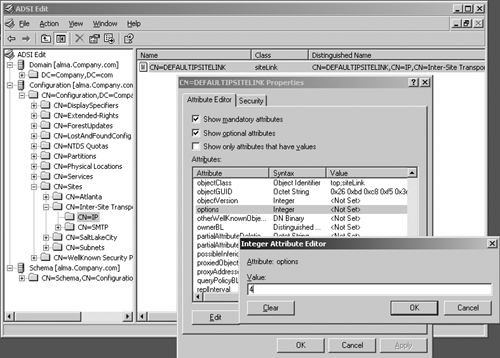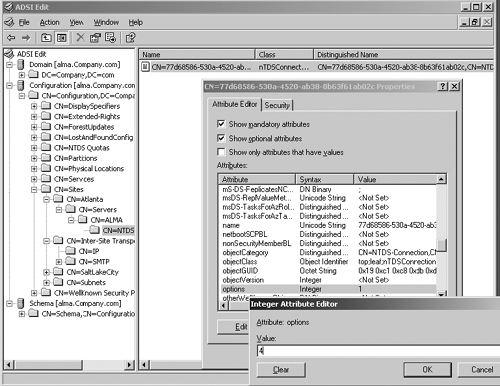5. GC Servers
GC servers are special-purpose DCs that hold a
writeable copy of all objects and attributes for the domain in which it
resides as a DC, and a read-only copy of all objects and some of their
attributes from other domains in the forest. Thus, GC servers are really
only important in multidomain forests and have no special function in
single-domain forests. The placement of GC servers in the enterprise is
an important design decision. The important tasks that GCs perform
include
Authentication for all users in a native-mode
domain in a multidomain forest. If a GC isn't available and no cached
credentials are on the computer, the user is denied logon ability. This
is because only a GC can enumerate universal security groups and apply
that information to the user's token at logon. A single-domain forest
ignores the necessity to contact a GC during logon.
Authentication for users logging on with the UPN. Logging on with a username in UPN format ([email protected]) will fail if a GC is not available.
Exchange
2000 and above uses the GC for the GAL. Exchange will preferentially
find a GC in the same site as the Exchange server. If one is not
available, Exchange will find one in the nearest site.
Services
users' requests for information in the AD, such as enterprisewide LDAP
(Lightweight Directory Access Protocol) queries performed by the user or
an application. For example, if an application performs LDAP queries to
locate resources such as users, file servers, and so on across a
multiple-domain environment, a local GC will improve that search
performance.
The placement of GCs in the enterprise has always
been a much-debated issue. Some companies put a GC in every site,
whereas others put multiple GCs in each site for redundancy. Compaq's
strategy was to put GCs in poorly connected sites, in prime sites on the
corporate backbone, and as few others as possible. The philosophy was
to utilize the network bandwidth as much as possible. If the network
bandwidth was sufficient between locations, Compaq would collect them
into a single site with a single DC and GC, thus utilizing the network
to reduce the need for GCs. For example, the entire country of Canada
only had 2 sites, and enterprisewide, only about 80 sites were serving
about 800 locations. Exchange 2000 caused GCs to be placed deeper in the
structure than originally anticipated, since it is used for Exchange's
Global Address List and is accessed frequently by users.
The key to GC placement is a good understanding of
the GC functions and how they fit in your computing infrastructure. In
the early days of Windows 2000, customers complained that the GC
authentication required them to place GCs in small, remote sites to
ensure authentication capability. Microsoft provided a Registry key (see
Microsoft KB 241789, “How to Disable the Requirement that a GC Server
Be Available to Validate User Logons”) that turned this feature off, but
warned that disabling this feature and using universal groups would
cause a potential security hole. To mitigate this issue, Microsoft
provided the Universal Group Membership Caching feature or Global
Catalog Caching feature in Windows Server 2003 .
This allows DCs to contact a GC on behalf of a user, obtain the user's
universal group membership, and cache it locally so the user can log on
if a GC is not available. This is done on a site-by-site basis, allowing
you to apply it on poorly connected sites that have a DC, but no GC.
This feature makes a big difference in deploying GCs. Now you can enable
GC Caching at a site until the population grows enough to justify a GC.
Another Windows Server 2003 feature that impacts GC deployment is the Install from Media (IFM) feature. IFM allows promotion of a member server to a DC or a GC using a
restored system state backup of another DC or GC in the domain. IFM not
only prevents a surge in network traffic while DCPromo runs, but also
significantly reduces the amount of time it takes to build a DC or GC.
HP identified IFM as a critical feature that contributed to the
company's deployment of Windows Server 2003 at RC2. Consider the problem
of GC failure for whatever reason. Broken replication, hardware
failures, and so on can cause GCs to have to be rebuilt. With less than
one GC per site, a GC failure impacted multiple sites. Further, with
Exchange depending on the GC, a failure caused Exchange transactions to
be serviced by a GC at another site. Rebuilding a GC of HP's size (the
database was 18GB at the time) took about 3 to 5 days, depending on the
location, network traffic, and so on. Using IFM, HP can rebuild a GC in
about 20 minutes. Even if HP had to build the media and ship it
overnight to the remote site, it's faster than doing it over the
network. Remember that the backup media for IFM has the same limitation
as other backup media; it has a useful shelf life of less than the tombstonelifetime period (default 60 days).
Placement of GC servers is a key element in an AD design.
6. Other Windows Server 2003 Replication Improvements
Improved Spanning Tree Algorithm
The spanning tree algorithm, used to calculate
intersite topology (least cost path), was completely rewritten using
Kruskal and Dijkstra's algorithms and made much more efficient. This algorithm allowed the KCC to calculate the topology for
3,000 sites and a single domain in about 30 seconds, although the
hardware resources affect this value. This is a major step in removing
scalability issues that were present in Windows 2000. Even if you don't
have an environment with hundreds of sites, this is important because
the efficiency of the spanning tree algorithm removes any design limits
that might be imposed by Windows Server 2003's scalability, allowing you
to design the infrastructure based on business needs rather than
Windows limits.
Improved Data Compression
Another improvement is the compression of data for
intersite replication. Data compression was a two-edged sword—it reduced
the size of the data to be transferred across the network by
approximately a factor of 10, but decompression required a huge hit on
the BHS in the target site to the point that DCs became overwhelmed with
that and other tasks, such as servicing outbound replication requests
from its partners, and the outbound partners didn't get serviced in a
timely manner, adding to latency. High latency can also happen if you
have a large number of sites replicating to a single BHS at the hub
site, a large number of sites causing the KCC to consume inordinate
amounts of CPU time, or a high frequency replication schedule. High
latency can cause replication to appear broken, and password changes,
policy changes, and other Group Policy changes are not replicated in a
timely manner. Microsoft improved the decompression engine in Windows
Server 2003 to drastically reduce the load on the DC. This was done at
the expense of compression ratio, being somewhat less than in Windows
2000, and slightly increasing the WAN traffic. Thus, Windows Server 2003
reduces the load on BHSs significantly, while increasing the WAN
traffic only slightly.
Because some environments might have low bandwidth
utilization in their network and can afford to replicate uncompressed
data to eliminate the decompression cost on the target BHS, Windows
Server 2003 provides a way to turn off compression of intersite
replicated data. This is accomplished by modifying the options
attribute on the site link and NTDS-Connections object. This can be
done via the ADSIedit snap-in (part of the support tools). Open the
snap-in by clicking Start, Run, and then entering adsiedit.msc. Expand the Configuration container, and then go to:
CN=Configuration,DC=Company,DC=com (where company.com is
the name of the domain)
CN=Sites
CN=Inter-Site Transports
CN=IP
Click on the CN=IP folder, right-click on
the site link in the right pane that you want to disable intersite
compression over, and select Properties. In the link properties page,
scroll through the attributes list to locate the Options attribute. Double-click the Options attribute and in the ensuing Integer Attribute Editor dialog box, enter 4, as shown in Figure 3.
Click OK twice to close the properties dialog boxes. This will
eliminate intersite compression on all connections using this link. You
can optionally configure this feature on individual connection objects
by setting the value of 4 on the Options attribute of the individual connection object, as shown in Figure 4.


warning
Disabling intersite compression is an advanced
feature of replication configuration. You should understand the
consequences of this action by thoroughly testing it in a lab
environment that represents your production network. Disabling
compression will cause an increase in traffic since you will have larger
amounts of data. You should document this action for troubleshooting
purposes. If your network is running close to capacity, there might not
be enough margin to support this feature, and might likewise be
difficult to diagnose as the cause of pushing the network over the
limit.
Load Balancing to BHSs
In addition, Windows Server 2003 implements a random
BHS selection process. As connections are made to a site, the ISTG
randomly selects an eligible DC for the BHS. This takes place as soon as
the DC joins the domain, unlike Windows 2000. In addition, Windows
Server 2003 implements the capability to balance replication schedules
by staggering the replication schedules of downstream partners.
Replication schedule staggering is implemented via Windows Server 2003's ADLB, available in the Resource Kit, downloadable from http://www.microsoft.com/windowsserver2003/techinfo/reskit/resourcekit.mspx.
Unfortunately, there isn't a lot of documentation on ADLB from
Microsoft, and the Resource Kit help file isn't much help either.
However, here are a few pointers:
The ADLB is run on sites with multiple DCs in
a domain. If there is only one DC in the site for any given domain,
ADLB won't help because it will have only one DC to manage.
ADLB
creates its own connections, and the KCC relinquishes control over
building and maintaining connections. Replication takes place over the
ADLB's connections.
Modifying site link
schedules and costs with the ADLB in place will not take effect because
replication is not using the KCC generated objects.
To
return to using the KCC's connection objects, just delete the
connections created by ADLB, and the KCC will generate new ones and
begin managing them.
To balance the BHS, run the
tool once per hub site. Run it again every time the topology changes. In
a large environment, you can balance the connections in stages to
soften the impact. In schedule balancing, ADLB changes schedules so that
they are balanced over time rather than randomized in normal KCC
behavior.